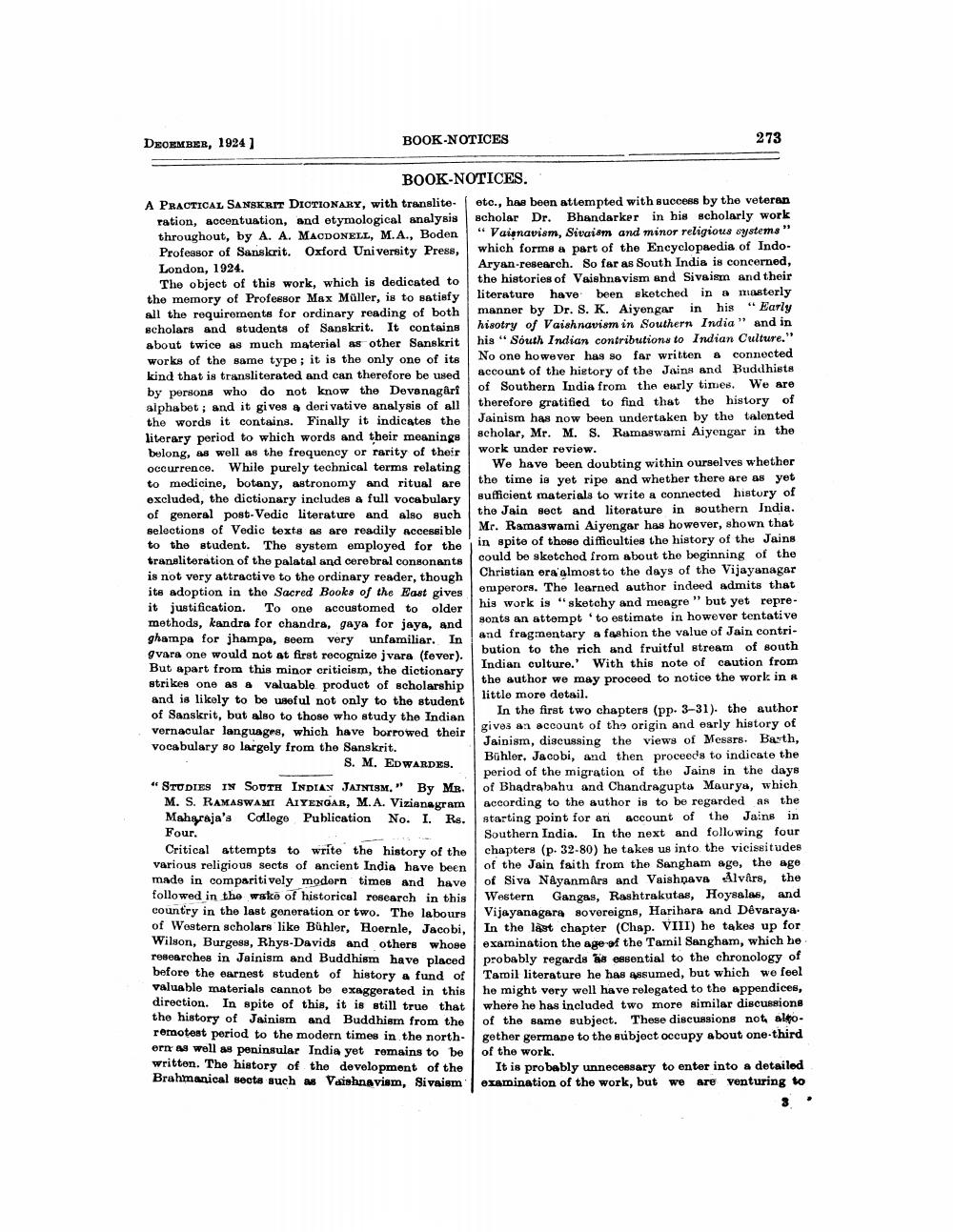________________
DECEMBER, 1924 ]
BOOK-NOTICES
273
BOOK-NOTICES. A PRACTICAL SANSKRIT DICTIONARY, with translite. etc., has been attempted with success by the veteran ration, accentuation, and etymological analysis scholar Dr. Bhandarker in his scholarly work throughout, by A. A. MACDONELL, M.A., Boden " Vai navism, Sivaiam and minor religious systems" Professor of Sanskrit. Oxford University Press, which forms a part of the Encyclopaedia of Indo. London, 1924.
Aryan-research. So far as South India is concerned, The object of this work, which is dedicated to the histories of Vaishnavism and Sivaism and their the memory of Professor Max Müller, is to satisfy literature have been sketched in a masterly all the requirements for ordinary reading of both manner by Dr. S. K. Aiyengar in his "Early scholars and students of Sanskrit. It contains hisotry of Vaishnavism in Southern India" and in about twice as much material as other Sanskrit his "South Indian contributions to Indian Culture." works of the same type ; it is the only one of its
No one however has so far written connected kind that is transliterated and can therefore be used
account of the history of the Jains and Buddhists by persons who do not know the Devanagari of Southern India from the early times. We are alphabet; and it gives & derivative analysis of all therefore gratified to find that the history of the words it contains. Finally it indicates the Jainism has now been undertaken by the talented literary period to which words and their meaninge scholar, Mr. M. S. Ramaswami Aiyengar in the belong, as well as the frequency or rarity of their work under review. occurrence. While purely technical terms relating We have been doubting within ourselves whether to medicine, botany, astronomy and ritual are the time is yet ripe and whether there are as yet excluded, the dictionary includes a full vocabulary
sufficient materials to write a connected history of of general post-Vedic literature and also such
the Jain sect and literature in southern India. selections of Vedic texts as are readily accessible
Mr. Ramaswami Aiyengar has however, shown that to the student. The system employed for the
in spite of these difficulties the history of the Jains transliteration of the palatal and cerebral consonants
could be sketched from about the beginning of the is not very attractive to the ordinary reader, though
Christian era almost to the days of the Vijayanagar its adoption in the Sacred Books of the East gives
emperors. The learned author indeed admits that it justification. To one scoustomed to older
his work is "sketchy and meagre" but yet repremethods, kandra for chandra, gaya for jaya, and
sonts an attempt to estimate in however tentative ghampa for jhampa, seem very unfamiliar. In
and fragmentary a fashion the value of Jain contrigvara one would not at first recognize jvara (fever).
bution to the rich and fruitful stream of south But apart from this minor criticism, the dictionary
Indian culture. With this note of caution from strikes one as a valuable product of scholarship
the author we may proceed to notice the work in and is likely to be useful not only to the student
little more detail. of Sanskrit, but also to those who study the Indian
In the first two chapters (pp. 3-31). the author vernacular languages, which have borrowed their
gives an account of the origin and early history of vocabulary so largely from the Sanskrit.
Jainism, discussing the views of Messrs. Basth, S. M. EDWARDES.
Bühler. Jacobi, and then proceeds to indicate the
period of the migration of the Jains in the days " STUDIES IN SOUTH INDIAN JATNISM." By ME. of Bhadrabahu and Chandragupta Maurya, which
M. S. RAMASWAMI AIYENGAR, M.A. Vizianagram according to the author is to be regarded as the Mahgraja's College Publication No. I. Rs. starting point for ari account of the Jains in Four.
Southern India. In the next and following four Critical attempts to write the history of the chapters (p. 32-80) he takes us into the vicissitudes various religious sects of ancient India have been of the Jain faith from the Sangham age, the age made in comparitively modern times and have of Siva Nayanmars and Vaishnava Alvars, the followed in the wake of historical research in this Western Gangas, Rashtrakutas, Hoyealas, and country in the last generation or two. The labours Vijayanagara sovereigns, Harihara and Devaraya. of Western scholars like Bühler, Hoernle, Jacobi, In the list chapter (Chap. VIII) he takes up for Wilson, Burgess, Rhys-Davids and others whose examination the age of the Tamil Sangham, which he researches in Jainism and Buddhism have placed probably regards to esential to the chronology of before the earnest student of history a fund of Tamil literature he has assumed, but which we feel valuable materials cannot be exaggerated in this he might very well have relegated to the appendices, direction. In spite of this, it is still true that where he has included two more similar discussione the history of Jainism and Buddhism from the of the same subject. These discussions nota altoromotest period to the modern times in the north- gether germade to the subject occupy about one-third orn as well as peninsular India yet remains to be of the work. written. The history of the development of the It is probably unnecessary to enter Brahmanical secta such as Vaishnavism, Sivaism examination of the work, but we are venturing lo




